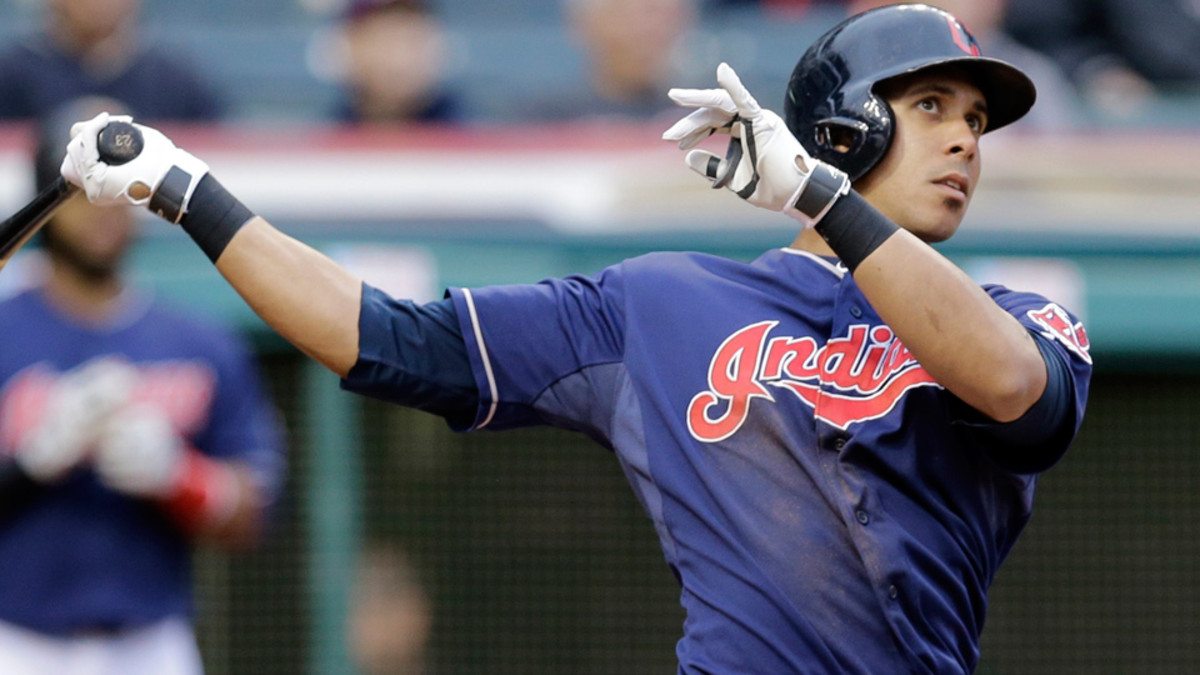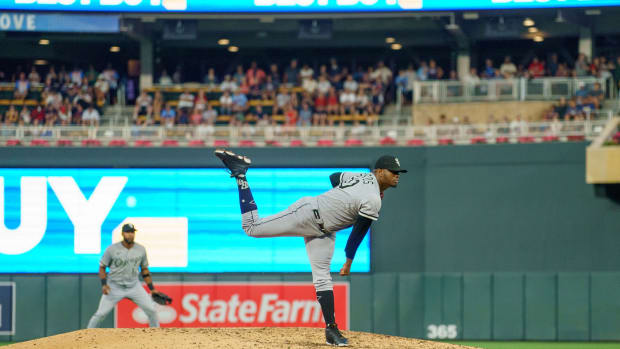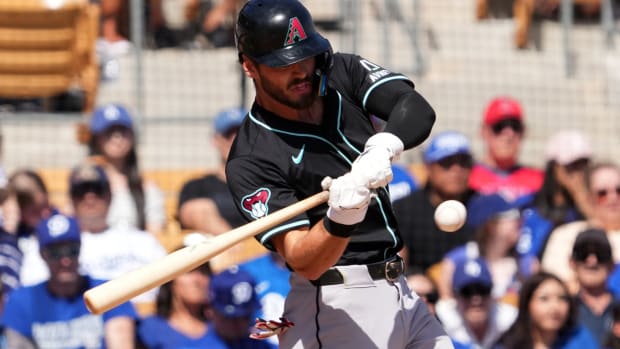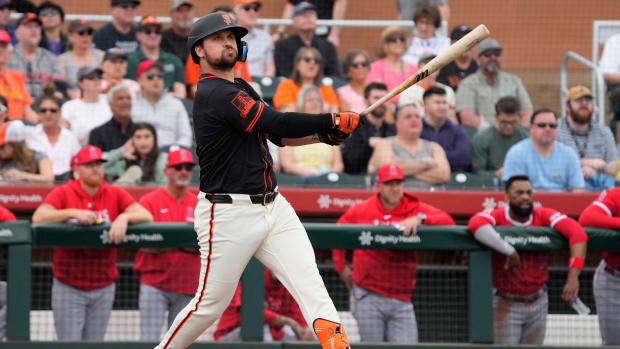Will 2014's breakout players repeat their star seasons or regress in '15?
With the start of the 2015 major league baseball season now less than a week away, we wanted to take a look at some of 2014’s breakout players to see how likely they are to maintain their new level of performance this year. It’s worth noting here that regression can be expected in every case. What’s at issue is just how dramatic that regression will be. Players are listed in alphabetical order.
Michael Brantley, LF, Indians
2014: 156 G, .327/.385/.506, 20 HR, 7.0 bWAR
Previous career: 514 G, .277/.330/.382, 26 HR, 6.2 bWAR
Brantley was a well-regarded minor leaguer when acquired in the CC Sabathia trade in July 2008, then established himself as a valuable part of Cleveland’s outfield in '11 at the age of 24, hitting .286/.340/.399 (109 OPS+) and averaging 2.8 bWAR in the two years prior to his breakout season. But while his baseline performance is higher than that of the other men on this list, his age-27 season—which resulted in his first All-Star appearance and a third-place finish in the American League Most Valuable Player voting—saw him more than double his career bWAR in a single year.
Indians head into 2015 with deep roster, World Series hopes
What was different? For starters, Brantley hit for an average 40 points above his previous two years combined and an isolated slugging 60 points above his previous career high. Both should regress in the coming season, though his .327 average was not the result of out-sized luck on balls in play. His .333 BABIP was high, but not abnormally so, and his outstanding strikeout-to-walk ratio (56:52) was not unprecedented in his career. He has now hit .301 over the last three years combined, and a similar average in 2015 seems well within reach. As for Brantley's power, it wasn’t all home runs. He also hit a career-high 45 doubles, a total not that far removed from his 37 in '12. There’s something real there, as well.
The average of Brantley’s last three seasons would seem to set a good level of expectation for the coming season. That would be something on the order of a .300/.350/.440 season with an OPS+ around 125 and maybe 15 home runs to go with another 20 stolen bases at a high rate of success. That may not be a third-place MVP finisher, but it’s still a tremendously valuable player.
• Sports Illustrated's World Series pick: Who will win it all in 2015?
Lucas Duda, 1B, Mets
2014: 153 G, .253/.349/.481, 30 HR, 3.7 bWAR
Previous career: 350 G, .246/.342/.424, 44 HR, -0.8 bWAR
Duda’s 2014 season wasn’t actually that wildly out of character. His batting average and on-base percentage were in line with his previous career marks, and his power has always been his calling card: He hit 23 home runs with a .265 isolated slugging in his last full minor league season in '10, then posted a .195 ISO in his first 129 major league games that September and in '11 and a .192 ISO in '13. Given all of that, his .228 mark last year wasn’t out of place for a player in his age-28 season.
Talented young pitching staff gives Mets hope for breakthrough 2015
What was different for Duda in 2014 was that the Mets didn’t ask him to play the outfield. In his first four major league seasons, Duda made just 72 starts at first base, but last year, he made 136, and it made all the difference. That pumped up his overall value (his brutal play in the pastures is why he had been a replacement-level player to that point) and gave the Mets the confidence to leave him in the lineup on an everyday basis. Left alone, Duda hit like Duda, and he’ll do it again in '15.
Josh Harrison, 3B, Pirates
2014: 143 G, .315/.347/.490, 5.3 bWAR
Previous career: 229 G, .250/.282/.367, 1.7 bWAR
It’s worth noting that Harrison hit .308/.357/.437 in parts of five minor league seasons, including a .314/.370/.486 line in 126 Triple A games. He can hit, as he finally got to prove in his age-26 season, falling four points shy of the National League batting title.
With deep and balanced roster, can Pirates finally claim NL Central?
There are actually a lot of similarities between Harrison and Brantley at the plate. Both have a contact-oriented approach that resulted in them having some of the shortest at-bats in the majors last year (Harrison saw 3.58 pitches per PA, Brantley 3.57, both in the bottom 15% of qualified batters). Both look like legitimate .290-plus hitters with inside-the-park power (Harrison hit 38 doubles and seven triples last year).
However, I have more doubts about Harrison’s plate approach than Brantley’s. Harrison drew just 21 unintentional walks last year to Brantley’s 48 and struck out 88 times to Brantley’s 56 despite the latter making 126 more plate appearances. A hitter who is just 5'8" should be seeing a lot more balls than Harrison does, and those ratios paint him as more of a hacker than Brantley. Harrison does make a lot of contact outside of the strike zone, but 59 qualified hitters in the majors made contact with pitches out of the zone more often in 2014, which challenges the idea of Harrison as a small, bad-ball hitter in the Yogi Berra mode. There’s potential here for collapse if he doesn’t get more selective, both at the plate and on the bases.
• Previewing and ranking each team ahead of the 2015 season
Phil Hughes, SP, Twins
2014: 209 2/3 IP, 3.52 ERA, 2.65 FIP, 11.63 K/BB, 4.3 bWAR
Previous career: 780 2/3 IP, 4.53 ERA, 4.31 FIP, 2.68 K/BB, 6.3 bWAR
As a prospect, Hughes was the only player of those listed here who was expected to be a full-blown star in the major leagues. A first-round pick in 2004 and a top-five prospect prior to the '07 season, Hughes was pegged as a franchise player for the Yankees, but it never quite worked out. Injuries derailed Hughes’ career in pinstripes early and often, as did diminishing stuff that led to constant tweaks of his repertoire. In his final four seasons with the Yankees, he was ordinary, inconsistent and generally incapable of the bare minimum of eating innings, averaging just 147 per season over that stretch. That Hughes was an extreme fly-ball pitcher in Yankee Stadium didn’t help: Opposing hitters slugged .470 against him at home over those last four years.
Twins' rotation, defense likely to doom them to AL Central cellar again
Hughes was so bad in New York that I doubted that even a move to homer-suppressing Target Field would help, but it did, and so did yet more tweaks to his repertoire. Last year, Hughes ditched his slider, changeup and the splitter with which he had experimented. In their place, he brought back his cutter, increased his use of his curve and introduced a sinker. That resulted in a slight increase in groundballs, and the combination of that and his new, more spacious ballpark gave him the confidence to pound the strike zone like he never had before, throwing 73.1% of his pitches for strikes and walking just 16 men (one intentionally) over a career-high 209 2/3 innings. The result was the sixth-lowest walk rate by a qualified pitcher since the creation of the American League (0.7 per nine innings) and the second-best strikeout-to-walk ratio since 1875 (11.63), as well as a drop in his home run rate by half and a seventh-place finish in the Cy Young voting.
There is no doubt that Hughes is going to regress from that, but he has room. His actual ERA was nine-tenths of a run higher than his fielding independent pitching mark thanks to his inflated .326 BABIP. With a little more luck on balls in play, he could allow a few more walks and homers and still hold tight around a 3.50 ERA. Unfortunately for Hughes, he’ll get no help from a Twins outfield that added the superannuated Torii Hunter to the defensively-challenged Oswaldo Arcia and Danny Santana. Hughes still isn’t really a star pitcher, but heading into his age-29 season, his future looks bright for the first time in years.
Dallas Keuchel, SP, Astros
2014: 200 IP, 2.93 ERA, 3.21 FIP, 1.18 WHIP, 5.0 bWAR
Previous career: 239 IP, 5.20 ERA, 4.78 FIP, 1.54 WHIP, -0.2 bWAR
Keuchel’s recipe for success in 2014 was the same as Hughes: fewer walks and homers, more ground balls. Beyond that, however, the two couldn’t be more different. Keuchel led the majors in ground-ball-to-fly-ball ratio last year, and that ability to get his opponents to beat the ball into the ground was the basis for his breakout season and why he should be able to repeat it, at least long enough to get everyone to pronounce his name correctly (KY-kill, not KUCH-ill).
Looking to escape AL West cellar, Astros place faith in streaky hitters
Keuchel threw more sinkers than ever before last year, and threw them harder than ever before. In addition, he ditched his curve and de-emphasized his cutter, resulting in a simplified sinker-slider-change attack with the latter two pitches looking very similar coming out of his hand. With increased confidence, he got ahead more often, reduced his walks and spiked his ground-ball rate, which took care of the homers. It’s a very repeatable formula, but like Hughes, Keuchel won’t be helped by his defense: The Astros replaced slick-fielding Matt Dominguez and Marwin Gonzalez on the left side of the infield with the less-capable Luis Valbuena and Jed Lowrie.
AL Breakout Players | NL Breakout Players | AL Busts | NL Busts
Corey Kluber, SP, Indians
2014: 235 2/3 IP, 2.44 ERA, 2.35 FIP, 5.27 K/BB, 7.4 bWAR
Previous career: 214 2/3 IP, 4.32 ERA, 3.61 FIP, 3.61 K/BB, 0.8 bWAR
Cover up that bWAR and Kluber’s pre-2014 numbers aren’t all that bad, which is exactly why I expect him to remain an elite pitcher in the AL in the coming season. As unexpected as Kluber’s Cy Young-winning season may have been, it was only the degree of improvement, not the mere fact of it, that came as a surprise.
Wrapping up a long spring training with its 10 biggest storylines
In 2013, Kluber posted a 3.30 FIP and a 4.12 K/BB in 24 starts and two relief appearances. Those are already excellent numbers, but what changed in '14 was that his luck evened out a bit in front of Cleveland’s lousy defense, with his BABIP dropping from .333 to .318. He increased his ground-ball rate, which brought down his home run rate. And, in the most radical departure from his previous performance, he added two strikeouts per nine innings, a result possibly tied to an uptick in velocity.
Kluber, who turns 29 next week, may be a late-bloomer, but he’s also a flat-out excellent pitcher at this stage of his career. That strikeout rate may regress this year, and outside of a potentially huge improvement at shortstop, the Indians' defense is largely the same as last year, but Kluber should continue to be a pitcher no one wants to face in 2015.
J.D. Martinez, RF, Tigers
2014: 123 G, .315/.358/.553, 23 HR, 4.2 bWAR
Previous career: 252 G, .251/.300/.387, 24 HR, -1.2 bWAR
For Tigers, another AL Central title hinges on lineup health, better bullpen
Again, note the minor league track record. Martinez hit .332/.394/.548 in parts of six minor league seasons, including .323/.390/.496 in 143 Double A games, but skipped Triple A when called up to help fill in the outfield of the rebuilding Astros in 2011. His hitting went backwards in his three years in Houston, to the point that the Astros, having moved on to a new batch of prospects, released him last spring in advance of his age-26 season. The Tigers signed Martinez just two days later, and less than a month later, Detroit began to reap the rewards of the work Martinez had done that winter to rebuild his swing with an emphasis on keeping his bat in the zone longer and getting on an even plane with the pitch.
Those changes were real, but there’s still considerable correction coming for Martinez. To begin with, he’s extremely unlikely to repeat his .389 BABIP from a year ago, and it’s not terribly likely that 13% of his fly balls are going to leave the park again, either (by way of comparison, Miguel Cabrera’s career averages are a .346 BABIP and 13.3% of fly balls becoming home runs). Still, we’re talking regression, not collapse. Start expectations with Martinez’s career line of .272/.319/.442 (which is his PECOTA projection almost exactly), nearly a third of which is last year’s performance. Round him up to a .280 average, which would push his slugging to .450 and add a little more power to reflect his minor league ISO and the increased backspin on the ball resulting from is rebuilt swing, and a .280/.325/.470 line doesn’t seem at all unreasonable.




































